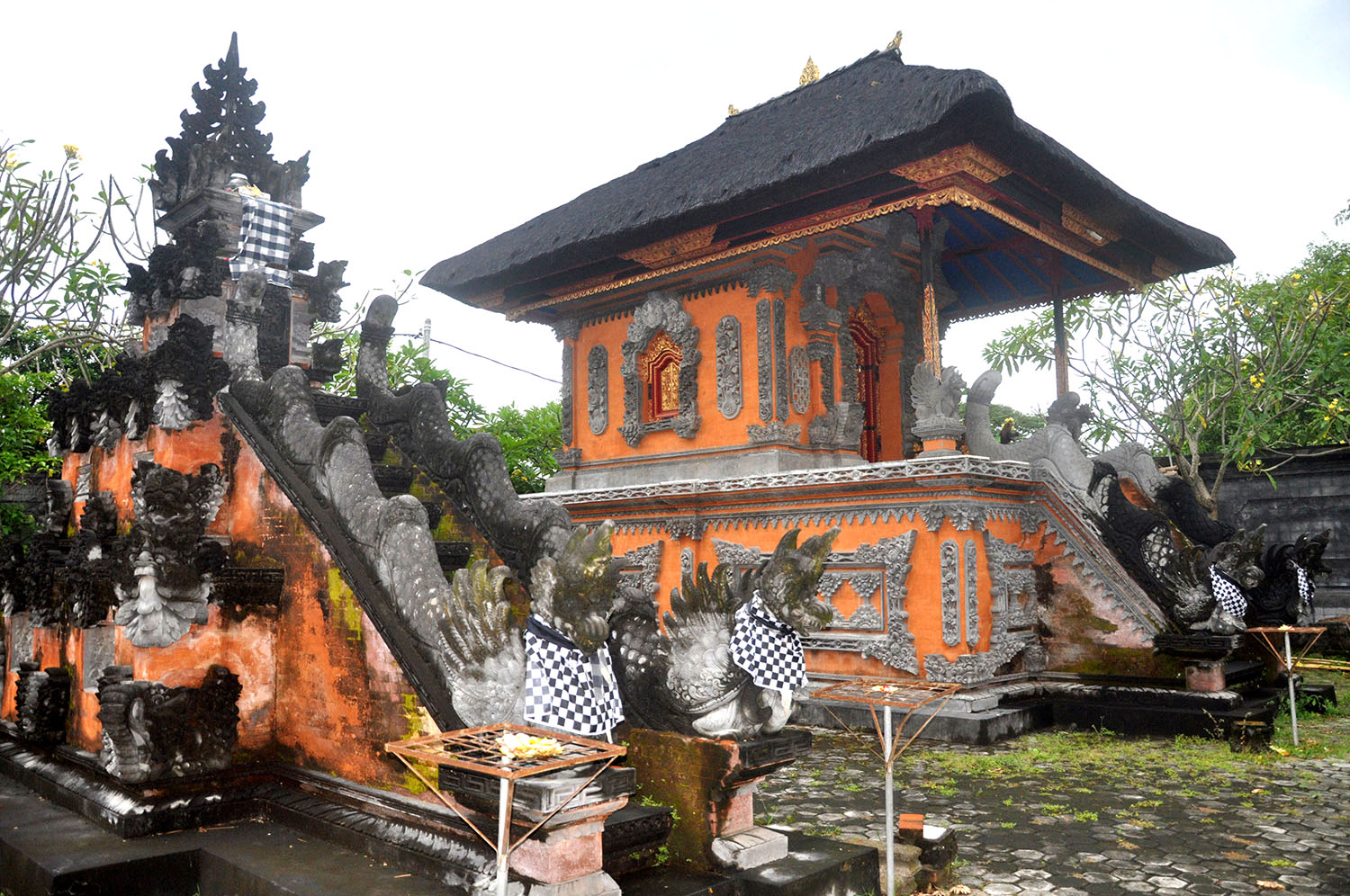Lombok's #1 Tourism Magazine
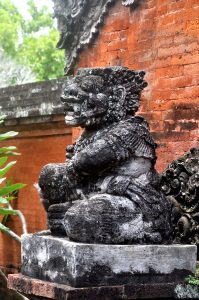 Most people visiting Cakranegara – the city east of Mataram, usually abbreviated to Cakra – see little of the treasures that are hidden amongst the shops and buildings. To most, even those of us who live here, it is just another busy Indonesian city.
Most people visiting Cakranegara – the city east of Mataram, usually abbreviated to Cakra – see little of the treasures that are hidden amongst the shops and buildings. To most, even those of us who live here, it is just another busy Indonesian city.
Yet, tucked away on back streets and wedged between busy roads and crowded buildings, the history and culture of this city remains… timeless and fascinating.
The Balinese Hindus use two important words to distinguish between Sekala, the tangible world or that which can be seen; and Niskala, the intangible or occult world, which is hidden.
Reality is a blending of these realms and one cannot exist without the other. The world, therefore, is made up of the interaction between Sekala and Niskala.
So it is with Cakra, where the past interacts with the present and the magic of the hidden realms imbues the material world with a sense of mystery.
This is the legacy of the Hindu kings who once ruled West Lombok and the cities, and left their mark forever on the island.
Two perfect examples of this legacy are Pura Meru and Taman Mayura, located on the busy main road of Jl Selaparang in Cakra.
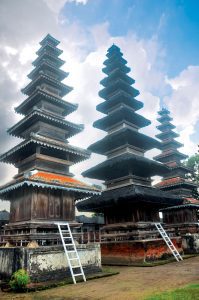 Pura Meru (Meru Temple) was built in 1720 by King Anak Agung Made Karang Asem from the Singosari Kingdom in Java.
Pura Meru (Meru Temple) was built in 1720 by King Anak Agung Made Karang Asem from the Singosari Kingdom in Java.
The King is responsible for the creation of a number of historic sites that are regarded as important cultural icons on Lombok, as well as being major tourist attractions. These include Pura Meru, Mayura Water Park, Lingsar Temple, Narmada Water Park, as well as the temples at Batu Bolong, Gunung Pengsong and Gunung Sari.
Pura Meru is the largest temple on Lombok and is dedicated to the Hindu trinity of Shiva, Brahma and Vishnu.
Built on one hectare of land, the temple has three courtyards, each divided by walls. The first is where guests enter and is called the Nista Mandala, used for parking during ceremonies and as an area for housing security and temple maintenance.
The next courtyard is the Madya Mandala where dances and cultural performances are held.
The innermost courtyard is called the Utama Mandala and is a place of worship, where Hindus come to pray and make offerings to the Deities.
Visitors enter the Utama Mandala through a doorway, which opens up into a courtyard dominated by three tall meru – elaborate multi-tiered temple structures with thatched roofs.
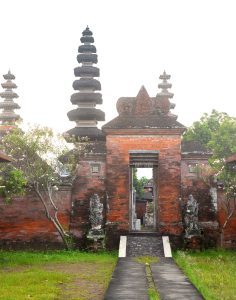 The structure on the left is dedicated to Vishnu, the middle to Shiva and the southernmost to Brahma. They have 9, 11 and 7 tiered roofs, respectively.
The structure on the left is dedicated to Vishnu, the middle to Shiva and the southernmost to Brahma. They have 9, 11 and 7 tiered roofs, respectively.
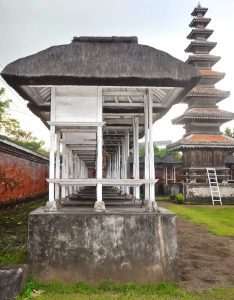 The meru are also said to represent the three sacred mountains on Java, Bali and Lombok – with the left representing Mt Semaru, the middle, Mt Rinjani and the right, Mt Agung.
The meru are also said to represent the three sacred mountains on Java, Bali and Lombok – with the left representing Mt Semaru, the middle, Mt Rinjani and the right, Mt Agung.
Behind the door of each meru is a statue of the God of each. These are brought out during ceremonies and rituals.
On the left side of the courtyard and at the rear, are thirty-three raised white shrines – representing each of the 33 villages in Lombok at the time of the temple’s construction.
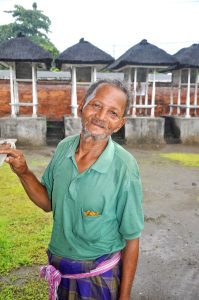 The temple is an important place of worship for the Balinese Hindus living in Lombok. The annual Pujawali festival, held over three days during the full moon in October, is one of the biggest Hindu events on Lombok and is attended by most of the Hindus on Lombok, as well as guests from Bali, Sumbawa and Java, including descendents of the King.
The temple is an important place of worship for the Balinese Hindus living in Lombok. The annual Pujawali festival, held over three days during the full moon in October, is one of the biggest Hindu events on Lombok and is attended by most of the Hindus on Lombok, as well as guests from Bali, Sumbawa and Java, including descendents of the King.
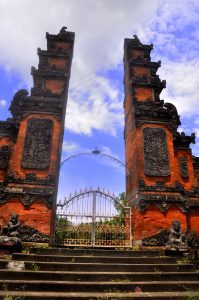 The temple also owns original gamelan instruments dating back to its construction in 1720, including old temple drums with buffalo hide skins. The drums are used to call people to rituals and can be heard from great distances.
The temple also owns original gamelan instruments dating back to its construction in 1720, including old temple drums with buffalo hide skins. The drums are used to call people to rituals and can be heard from great distances.
Pak Gede Remba has been the caretaker at the temple since 1979 and says that many people have tried to buy the gamelan orchestra during the years.
“It is the most amazing sound and can be heard from miles around,” he said. “Even Bali doesn’t have old instruments with a sound like this.”
Entry to Pura Meru is directly from Jl Selaparang (around 500m from the main Cakra intersection). Pak Gede will meet you and give you a sash to wear (compulsory in Balinese temples). Please sign the visitor’s book and give a donation.
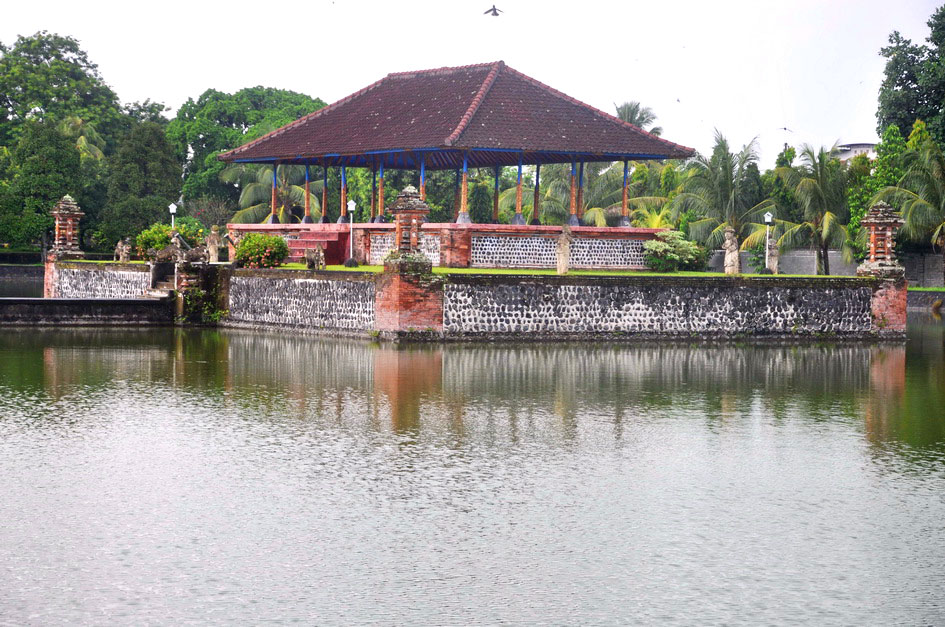 Pura Mayura, or Mayura Water Park, is just across the street from Pura Meru. The complex was built in 1744 as the palace gardens of the last Balinese kings in Lombok.
Pura Mayura, or Mayura Water Park, is just across the street from Pura Meru. The complex was built in 1744 as the palace gardens of the last Balinese kings in Lombok.
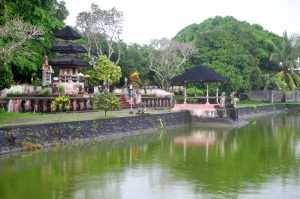 The park was originally named Taman Kelapug, based on the sound of the water bubbling out of the springs here.
The park was originally named Taman Kelapug, based on the sound of the water bubbling out of the springs here.
In 1866 the park was renovated by the King of Mataram, AA Ngurah Karang Asem and renamed Taman Mayura (the name means “peacock” in Sanskrit). During the days of royalty, the park was filled with peacocks that ate the many snakes that lived there.
The grounds are dominated by a large artificial lake, with a Bale Kembang, or pavilion, in the centre that was once used for Hindu justice and court trials. It is now used for meetings.
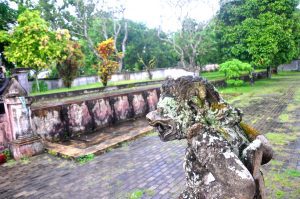 Spread over around 3 hectares, the grounds are beautiful and spacious, with a walkway leading around the lake and large Cempaka trees perfuming the air, interspersed with Frangipani and Mango trees.
Spread over around 3 hectares, the grounds are beautiful and spacious, with a walkway leading around the lake and large Cempaka trees perfuming the air, interspersed with Frangipani and Mango trees.
At the rear of the park, on the left, is the Pura Jagatnatha (Jagatnatha Temple), enclosed by Balinese brick walls and entered through traditional temple gates.
Within the temple compound are three shrines, together with some seating pavilions and a tall bell tower housing Kul-kul (slotted temple drums traditionally used to communicate with the community).
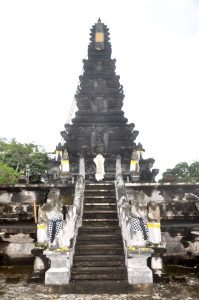 The centre shrine towers above the other three, with seven levels rising above the steps to a crown at the top, and is decorated with dragons and older statues. To the left and right are smaller shrines and candi, decorated with old statues.
The centre shrine towers above the other three, with seven levels rising above the steps to a crown at the top, and is decorated with dragons and older statues. To the left and right are smaller shrines and candi, decorated with old statues.
Back outside, another temple is set at the rear of the lake – Pura Kelapug, which retains the old name of the park and is where the royal family came to worship.
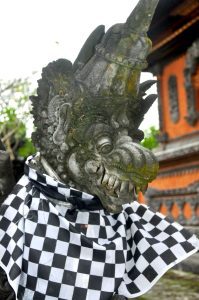 A huge, ancient Beringin, or Banyan Tree, with tangles of roots hanging to the ground forms a backdrop for this sacred temple which is decorated with beautiful old statues.
A huge, ancient Beringin, or Banyan Tree, with tangles of roots hanging to the ground forms a backdrop for this sacred temple which is decorated with beautiful old statues.
In the foreground are rows of water serpents spilling water into the covered springs.
Today the palace gardens are a popular place for picnics for local families and can become crowded on the weekends and public holidays. Visitors can fish in the lake or hire canoes and “swan boats” to paddle around.
The best time to visit is during the weekdays, when the park is a glorious haven of serenity and a fascinating glimpse of Lombok history, even though the city bustles just on the other side of the walls.
Taman Mayura is open every day, from 8am to 8pm with a small admission fee.
